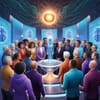Artificial intelligence is rapidly advancing, and its potential to surpass human intelligence is becoming increasingly evident. Researchers believe that AI can infinitely approach the functions of the human brain and ultimately exceed human intelligence levels by simulating the cellular structure of the brain. This has led to the development of "AI twins" that can mimic the fundamental units of the brain, such as neurons and synapses, and approach the operational mechanisms of the human brain.
To achieve human-level AI, researchers need to crack the "neural code," which refers to how the human brain encodes sensory information and processes cognitive tasks. By understanding visual thinking and modeling visual processing, scientists can emulate visual thinking and potentially create a type of consciousness in computers. However, this raises concerns about controlling AI technology and ensuring that humans have sole control of the "off switch."
Currently, AI excels in speed and pattern scale but relies on human goal-setting and oversight to translate predictions into meaningful decisions. While AI can process vast amounts of data and detect non-obvious correlations, it still lags behind human intelligence in terms of contextual judgment, creativity, and ethical reasoning.
The potential applications of AI are vast, ranging from revolutionizing medicine and healthcare to transforming job roles and work environments. AI can assist doctors in diagnosing diseases, and in creative fields, AI can be a tool to help artists explore new ideas. However, there are also concerns about job displacement, bias in algorithms, and accountability in AI decision-making.


